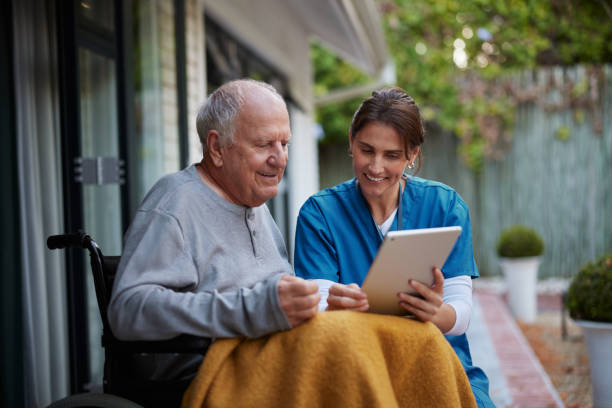In today’s increasingly mobile society, more families find themselves separated by cities, countries, or even continents. For adult children and relatives tasked with supporting aging parents or loved ones from afar, this reality presents a complex set of emotional, logistical, and financial challenges. Long-distance caregiving isn’t simply about checking in via video calls—it involves coordinating medical care, managing finances, navigating communication with on-the-ground providers, and handling the weight of responsibility without the immediacy of physical presence.
This blog examines the challenges of long-distance caregiving and offers practical guidance to help families provide quality care, even from great distances.
Understanding the Emotional Toll
One of the most underestimated aspects of long-distance caregiving is the emotional strain it places on the caregiver. Feelings of guilt, helplessness, and worry are common. You may constantly wonder if you’re doing enough, if your loved one is being honest about their condition, or if you’ll be able to reach them quickly in an emergency. This emotional dissonance often leads to caregiver burnout, even if the tasks involved don’t seem overwhelming on the surface.
To address this, it’s essential to create a structured emotional support system for yourself. This might include therapy, caregiver support groups (virtual or in-person), or simply maintaining regular contact with siblings and extended family members involved in the care. Sharing responsibility and maintaining transparency within the family can ease the psychological burden and reduce miscommunications.
Coordinating Medical and Daily Care from Afar
Another significant hurdle is managing medical needs from a distance. This includes everything from ensuring medication adherence to coordinating doctors’ appointments and tracking changes in health status. Without direct observation, it can be difficult to gauge subtle shifts in cognitive function, mobility, or mood that may indicate the need for further care.
Technology can offer crucial support here. Digital pill dispensers, remote monitoring devices, and patient portals can keep caregivers informed about vital signs and medication schedules. Make sure your loved one’s primary care provider and any specialists have your contact information and that you’re authorized to receive updates under HIPAA or local data privacy laws.
Additionally, building a reliable local network—whether it’s trusted neighbors, home health aides, or a geriatric care manager—can serve as your eyes and ears on the ground. These individuals can provide immediate updates and help in emergencies, serving as an essential lifeline when you cannot be physically present.
Financial Management and Legal Responsibilities
Handling finances and legal matters is often part of the long-distance caregiving role, particularly if the loved one is unable to manage these aspects independently. From paying bills and handling insurance claims to overseeing long-term care planning, the responsibilities can be extensive.
Setting up a power of attorney (POA) is a key step that allows caregivers to legally make decisions on behalf of their loved one. It’s also wise to arrange access to online banking, bill payment systems, and secure digital document storage to simplify the management of financial tasks.
Work closely with a financial advisor or elder law attorney, if possible, to review estate plans, discuss potential long-term care options, and understand tax implications of caregiving-related expenses. Proactively addressing these legal and financial frameworks ensures you’re equipped to act swiftly and appropriately when needed.
Communication Challenges with Family and Providers

Maintaining clear and consistent communication across multiple parties—healthcare providers, family members, caregivers, and the care recipient—is a critical but often frustrating part of long-distance caregiving. Misunderstandings, missed updates, or fragmented information flow can disrupt care and create conflict.
To reduce confusion, establish a single communication hub, such as a shared digital calendar or a caregiving app, where all appointments, medications, notes, and contact details are stored. This centralized system allows everyone involved to stay on the same page.
Regularly scheduled video calls with your loved one can also serve as both emotional check-ins and informal health assessments. Pay attention to subtle changes in speech, appearance, or behavior that might not be disclosed explicitly.
Knowing When to Visit—or Step In
One of the hardest decisions for long-distance caregivers is determining when it’s time to make an in-person visit. While regular check-ins may suffice for stable situations, sudden medical issues, transitions in care, or emotional crises may require your presence.
Plan periodic visits even when there’s no emergency. These visits allow for direct observation of living conditions and can reassure your loved one of your ongoing involvement. They also provide opportunities to meet with medical professionals or service providers face-to-face, strengthening your caregiving network.
When signs indicate a need for more intensive support—such as frequent falls, memory loss, or signs of neglect—it may be time to consider bringing in professional full-time care or relocating your loved one to a facility closer to you.
Final Thoughts: Caregiving Without Borders
Long-distance caregiving demands a careful blend of compassion, coordination, and resilience. While physical absence can amplify challenges, proactive planning, smart use of technology, and a strong local network can help bridge the gap. Most importantly, recognize that caregiving isn’t defined solely by presence but by intention and consistency. Supporting a loved one from afar is a testament to love across miles, and with the right systems in place, it can be both effective and deeply meaningful.


Recent Comments